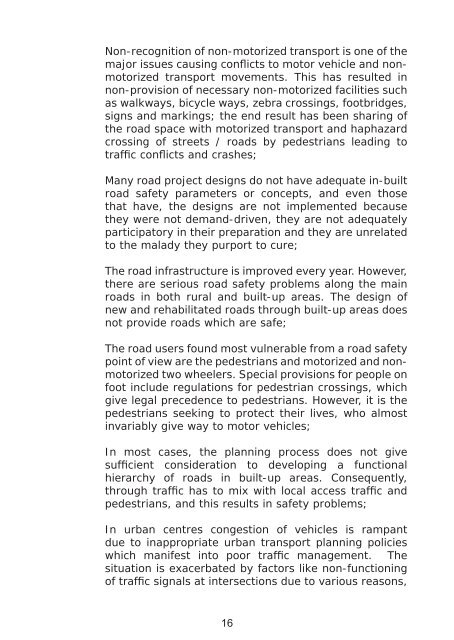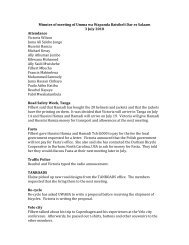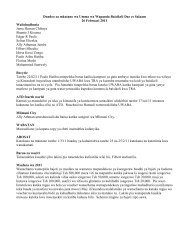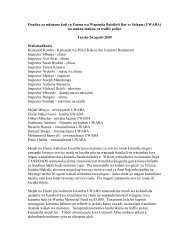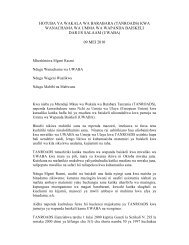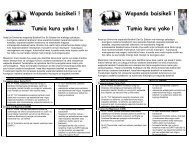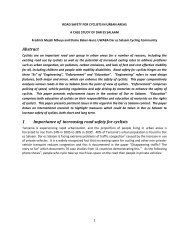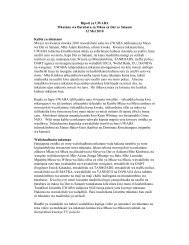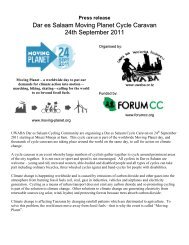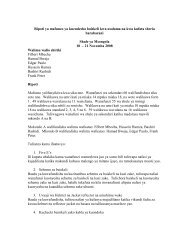National Road Safety Policy of 2009 - Uwaba.or.tz
National Road Safety Policy of 2009 - Uwaba.or.tz
National Road Safety Policy of 2009 - Uwaba.or.tz
Create successful ePaper yourself
Turn your PDF publications into a flip-book with our unique Google optimized e-Paper software.
• Non-recognition <strong>of</strong> non-mot<strong>or</strong>ized transp<strong>or</strong>t is one <strong>of</strong> the<br />
maj<strong>or</strong> issues causing conflicts to mot<strong>or</strong> vehicle and nonmot<strong>or</strong>ized<br />
transp<strong>or</strong>t movements. This has resulted in<br />
non-provision <strong>of</strong> necessary non-mot<strong>or</strong>ized facilities such<br />
as walkways, bicycle ways, zebra crossings, footbridges,<br />
signs and markings; the end result has been sharing <strong>of</strong><br />
the road space with mot<strong>or</strong>ized transp<strong>or</strong>t and haphazard<br />
crossing <strong>of</strong> streets / roads by pedestrians leading to<br />
traffic conflicts and crashes;<br />
• Many road project designs do not have adequate in-built<br />
road safety parameters <strong>or</strong> concepts, and even those<br />
that have, the designs are not implemented because<br />
they were not demand-driven, they are not adequately<br />
participat<strong>or</strong>y in their preparation and they are unrelated<br />
to the malady they purp<strong>or</strong>t to cure;<br />
• The road infrastructure is improved every year. However,<br />
there are serious road safety problems along the main<br />
roads in both rural and built-up areas. The design <strong>of</strong><br />
new and rehabilitated roads through built-up areas does<br />
not provide roads which are safe;<br />
• The road users found most vulnerable from a road safety<br />
point <strong>of</strong> view are the pedestrians and mot<strong>or</strong>ized and nonmot<strong>or</strong>ized<br />
two wheelers. Special provisions f<strong>or</strong> people on<br />
foot include regulations f<strong>or</strong> pedestrian crossings, which<br />
give legal precedence to pedestrians. However, it is the<br />
pedestrians seeking to protect their lives, who almost<br />
invariably give way to mot<strong>or</strong> vehicles;<br />
• In most cases, the planning process does not give<br />
sufficient consideration to developing a functional<br />
hierarchy <strong>of</strong> roads in built-up areas. Consequently,<br />
through traffic has to mix with local access traffic and<br />
pedestrians, and this results in safety problems;<br />
• In urban centres congestion <strong>of</strong> vehicles is rampant<br />
due to inappropriate urban transp<strong>or</strong>t planning policies<br />
which manifest into po<strong>or</strong> traffic management. The<br />
situation is exacerbated by fact<strong>or</strong>s like non-functioning<br />
<strong>of</strong> traffic signals at intersections due to various reasons,<br />
16


